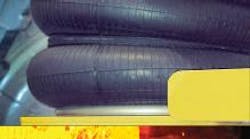For more than 50 years, air actuators have played a key role in many pneumatically powered machines. Air actuators differ from metal pneumatic and hydraulic cylinders in that they have no piston rods and cylinder barrels. Instead, the simple and cost-effective design somewhat resembles a flexible rubber bellows. But construction is similar to that of a car tire, giving the devices toughness, pressure resistance, and dimensional stability.
Who, What, Where Edited by Kenneth J. Korane, [email protected] Key points Resources ContiTech North America, (317) 845-5203, www.contitech-online.com/airactuators |
A prime advantage is that air actuators do not need the dynamic seals that are essential — and, at times, a headache — in traditional cylinders. This means there is no path for external contamination to enter the air actuator. It eliminates breakaway (stick-slip) friction that can plague cylinders in low-load or low-speed conditions, so the actuators respond immediately and uniformly even to small pressure variations. And because there are no seals to wear out, service life is often much longer than that of metal cylinders, especially in adverse environments.
Standard-elastomer construction handles temperatures from –40 to 160°F, though units for higher and lower temperatures are available. Types of air actuators include single, double, and triple-convolution bellows, as well as rolling-lobe designs, in a wide range of sizes. The ContiTech line, for instance, ranges from 2 to 40 in. in diameter. With a maximum working pressure of 115 psi, the actuators generate compression forces or support loads to 67,000 lb. In addition, designs with reinforced internal materials handle pressures to 175 psi.
Other advantages:
Durability. Because the actuators have no seals or rubbing parts, they do not wear even when exposed to dirt, dust, granular materials, or sediments — making them essentially maintenance-free. They are also unaffected by weathering, many chemicals, and have a long service life even when heavily loaded.
Lateral misalignment capacity. Due to inherent flexibility, air actuators operate reliably when misaligned up to 1 in. Compensating for slight misalignments also simplifies installation. And there is no need for precision guides which are sensitive to dust and other contamination.
Low height. Because air actuators do not have piston rods, machine designs can be more compact than those using conventional pneumatic cylinders.
Multimedia. Air actuators typically run on industrial compressed air. But they also work well with oil-free air, making them suited for special applications in the food and medical industries. They also operate with other gases, including nitrogen, and even low-pressure hydraulic media such as water and glycol.
Tilt motion. Air actuators can stroke through an arc, letting designers simplify articulated constructions. Maximum tilt angle varies with actuator type and kinematics but, for triple-convolution air springs, it’s up to 30°.
Safety. Burst pressure is several times greater than the maximum working pressure.
Low cost. Up-front costs are considerably less than those for conventional pneumatic cylinders of the same size. And long service life and low maintenance keep operating costs down, too.
Design considerations
When weighing air actuators versus other options, consider these factors:
Lateral guidance. Actuator stability can vary greatly and depends on the type, size, internal pressure, and height. Therefore, lateral guidance is advisable. In many applications, the overall machine design (lever arm, scissors construction) provides the necessary lateral guidance.
End stops. Air actuators must have external stops at the ends of stroke. They are not designed to withstand forces that arise when extended or compressed excessively without external stops. Actuators inflated without a load can suffer damage and risk injury.
Air consumption. An air actuator’s outer diameter is somewhat larger than the effective diameter. Therefore, calculate air consumption based on volume curves in manufacturers’ datasheets, not on the effective area and stroke.
Installation space. Working space must allow for changes in the actuator’s diameter over the entire stroke. The bellows must not rub against machine parts or against itself. Take extra care that actuators do not chafe when operating in tilted positions.
Selection factors
To properly size an actuator, here are some additional design considerations.
Stroke length. Air actuators have a minimum (compressed state) and maximum (no end stop) design height. Maximum working stroke is the difference between the two. For longer strokes, use a mechanical scissors design or stack two or more actuators end-to-end. In the latter case, mounting plates with lateral guides must be fitted between each pair of actuators.
Force. Unlike conventional pneumatic cylinders, an air actuator’s effective diameter dw (and, thus, effective working area) is not the same as its outer diameter. Complicating matters, dwcan change with operating height. Therefore, exerted force decreases progressively with stroke, and this decrease varies according to the size and type of unit. Check the manufacturer’s force/stroke data to determine force output and pressure requirements at maximum stroke.
Return force. Air actuators operate like single-acting cylinders in that they need a return force to retract the actuator to its compressed position. Actuator datasheets list this force. Convolution air springs can function when completely depressurized. Sleeve type and rolling-lobe actuators, however, require a minimum pressure to let the bellows roll down over the piston. Datasheets specify minimum pressure requirements.
Applications
Air actuators are used instead of pneumatic or hydraulic cylinders in a wide range of applications, including material-handling equipment, agricultural machinery, food processing, paper and textile equipment, punch and forming presses, and sawmill machinery.
They are especially suited for applications with adverse ambient conditions and high-force requirements. Typical examples include low-temperature (–75°F) wood-processing applications or high-temperature glass and paper manufacturing with sustained temperatures of 240°F and peak temperatures reaching 265°F.
